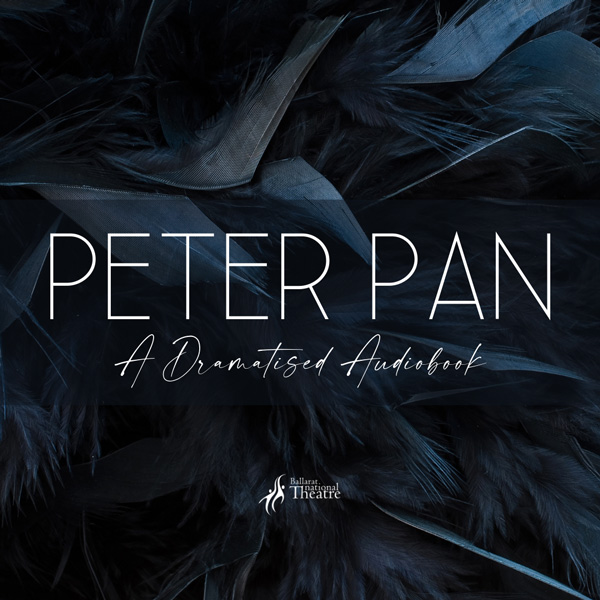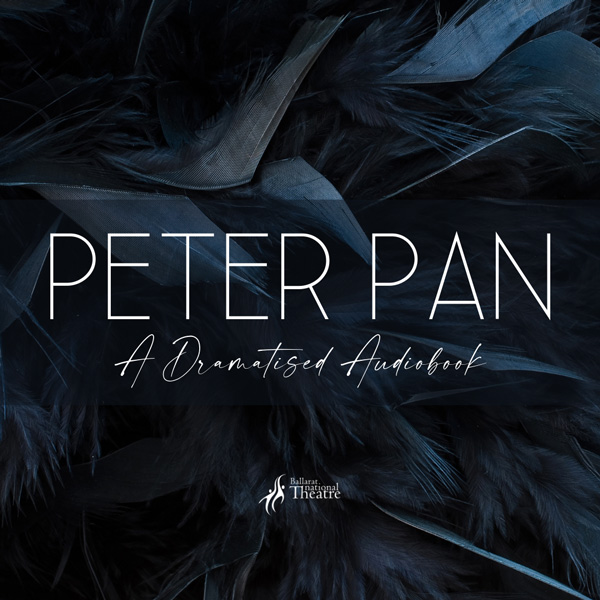You may have been wondering what we have been doing since Pride and Prejudice and Olivia has been up to a whole lot!
She has been directing a podcast adaption of Peter Pan with Elizabeth Bradford and Marli van der Bijl.
Each episode features the voices of Australian actors, transporting you to a magical world of mermaids, pirates, fairies and marvellous adventures that the whole family can enjoy.

Synopsis
Peter Pan, the mischievous boy who refuses to grow up, lands in the Darlings’ proper middle-class home to look for his shadow. He befriends Wendy, John and Michael and teaches them to fly—with a little help from fairy dust. Pan and Tinker Bell whisk the children off to the Neverland where they encounter the Lost Boys, the Neverlanders and the dastardly Captain Hook and his crew.
About the Novel
James Matthew Barrie was born on 9 May 1860 in Scotland. When he was six years old, his older brother, David, died in an ice-skating accident. David remained forever in their mother’s eyes as the boy who would never grow up—this later served as inspiration for Peter Pan. After David’s death, Barrie tried to take over the role of favourite in their mother’s life. This relationship, whilst rumoured to be quite fractured, certainly helped foster Barrie’s interest in women’s identities—how we understand women’s roles like mother, wife, sister, leader. We can see these questions at work in his portrayal of female characters like Mrs Darling, Wendy, Tiger Lily and Tinker Bell.
While living in London, Barrie befriended the Llewelyn Davies family during his frequent walks in Kensington Gardens. The five boys (George, John, Peter, Michael, and Nicholas) became the inspiration for the character Peter Pan and several of the characters within Barrie’s later works are named after the boys. When the Davies boys’ father passed away, Barrie financially supported the family and when their mother, Sylvia, died a few years later, he became co-guardian. Barrie died on 19 June 1937. Peter Pan remains his most famous work.
About the Adaptation
The story of Peter Pan has long captured the imagination of children around the world. At its core, it’s a story of childhood innocence and adventure. Within the writing itself however, there is a great deal to be unpacked. Exploring some of the darker themes within Barrie’s iconic tale has provided us with the opportunity to examine different thematic elements with our adult cast, whilst still engaging with the more light-hearted elements with our child cast. This decision and process was as rewarding for our cast as it was for us, and we hope that you enjoy both the light and the dark that our production has to offer. Similarly, careful consideration has been applied to all elements of sound design and music in our production—the latter of which includes some original compositions by our incredibly talented cast.
While our adaptation remains faithful to Barrie’s original work and ideas, changes have been made. Like many classic texts, the story does contain elements which are controversial and do not reflect the views and beliefs of modern audiences; in particular the depiction of racist stereotypes within the text. These depictions, though more commonplace at the time of the story’s creation, were as wrong then as they are today. It was never our intention to ignore these issues, to do so might suggest these prejudices are in any way acceptable, and as such, there are modifications to the original text. Throughout this adaptation, our cast and creative team have been actively involved in discussing, examining and addressing the prejudices within the text to help ensure that this dramatisation presents a more tolerant, inclusive retelling of Peter Pan.
Here, the Neverlanders are the people indigenous to the Neverland. Their connection to the story is deeply rooted in the significance that they have to the land itself and the characters are named after trees. This was instrumental to informing our decision around the native tribe within the original story. The Neverlander language consists of a mostly English vocabulary, interspersed with Latin phrases. We have worked closely with our actors to establish an ancient language/accent featuring root sounds closely resembling those found in Latin.
Another aspect of our adaptation was to give voice to a strong young woman already represented in the text: Tiger Lily. A prominent feature in all versions of Peter Pan, Tiger Lily represents strength and grace but did not originally have much dialogue at all. In consultation with our cast, the production team gave the character greater scope to show her to be the powerful, dynamic character that she is. In addition, her tribe members were also expanded to provide insight into the Neverlanders perspectives and the origins we collaboratively devised. While our retelling differs from Barrie’s, we hope to present a more representative and empathic portrayal of all characters but especially Tiger Lily’s tribe, the Neverlanders.
Podcast Theme Song
The Pan Podcast Team had been looking for a song that sounded like Peter Pan, but after finding many songs that almost just worked, they were at their wits end. They didn’t want to use music that had been used elsewhere in the digital universe and were looking for music that captured the adventure, but also had darker themes. Some instruments specifically stood out, like the pan flute to signify Peter Pan and the piano – Mrs Darling plays Home Sweet Home on the piano in the final chapters of the novel.
About a week out from the podcast’s release, one of the Pan Team started thinking about composers they knew and remembered Stamatis Seraphim who they had met back in 2017. Through social media they found that Stamatis later went on to pursue his studies in London and had become a budding composer. They found his Bandcamp profile and listened to some of the music he had composed, finding the composition Nefeli.
The Team were drawn to the adventurous violins; they could hear the pirates, the piano in the nursery, wind instruments and some magical bells. It had many different movements which could be used at different points in the audiobook as the intrigue unfolds. Nefeli means clouds, so it was destiny!
Here’s what Stamatis had to say about the composition and his thought process behind it:
“Nefeli is dedicated to my other half and named after her. I wanted to reflect a different side of her than what a typical love theme would do. Instead of sweeping strings and romance, I wanted to bring out what I see when I look at her. She’s such an intelligent person and you can see the thoughts going in and out of her head behind her eyes, hence the rhythmical nature of the piece. There are some romantic phrases present but always with the rhythmical motif behind them. There’s inspiration from the music of The Queen’s Gambit by Carlos Rafael Rivera, and I thought using something as finessed and diverse as the orchestra along with a piano, which is my main instrument, was the best way to represent that side of Nefeli.”
Visit Stamatis Seraphim’s website to find out more about the composer https://stamsera.com/
